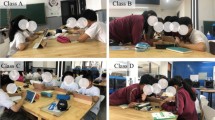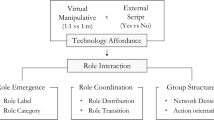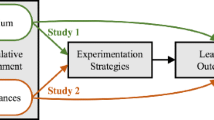Abstract
In scientific inquiry learning, manipulatives have been widely utilized as learning resources. Studies have explored the advantages of virtual manipulative (VM) for conceptual understanding and knowledge construction in science education. However, research on the mental engagement and perception of students during collaborative learning under different modalities of using VM remains rare. In this study, we designed a virtual lever manipulative (VLM) and three modalities of using VLM in a primary science course: one VLM per student, one VLM per group, and one VLM per class. There were 80 fifth graders from three classes who participated in this quasi-experimental study. They were asked to complete a group worksheet during collaborative learning activities. Cognitive load, as well as flow experience, was invested through a questionnaire survey after the learning activities. Task involvement was calculated by using the mental effort dimension of cognitive load and post-test scores. The findings indicate that class B (one VLM per group) gained the highest scores in group worksheet and the post-test 1 week later, followed by class C (one VLM per class) and class A (one VLM per student). Class B had the highest level of task involvement, as they had a shared screen among group members. In contrast, class A had a relatively low task involvement and spent more time checking consistency. Besides, both classes A and B had a higher sense of flow experience than class C. Class C experienced a traditional teaching method and less interaction with learning materials, leading to a lower level of flow experience and moderate task involvement.





Similar content being viewed by others
References
Bell, T., Urhahne, D., Schanze, S., & Ploetzner, R. (2010). Collaborative inquiry learning: models, tools, and challenges. International Journal of Science, 32(3), 349–377.
Bouck, E. C., & Flanagan, S. M. (2009). Virtual manipulatives. Intervention in School and Clinic, 45(3), 186–191.
Cáceres, M., Nussbaum, M., Marroquín, M., Gleisner, S., & Marquínez, J. T. (2018). Building arguments: key to collaborative scaffolding. Interactive Learning Environments, 26(3), 355–371.
Cohen, J. (1988). Statistical power analysis for the behavioral sciences (2nd edn.). New Jersey: L. Erlbaum Associates.
Crompton, H., Burke, D., Gregory, K. H., & Gräbe, C. (2016). The use of mobile learning in science: a systematic review. Journal of Science Education and Technology, 25(2), 149–160.
Crompton, H., Burke, D., & Gregory, K. H. (2017). The use of mobile learning in PK-12 education: A systematic review. Computers in Education, 110, 51–63.
Csikszentmihalyi, M. (1990). Flow: the psychology of optimal experience. New York: HarperCollins Publishers.
Ghani, J. A., & Deshpande, S. P. (1994). Task characteristics and the experience of optimal flow in human—computer interaction. The Journal of Psychology, 128(4), 381–391.
Ha, O., & Fang, N. (2017). Interactive virtual and physical manipulatives for improving students’ spatial skills. Journal of Educational Computing Research, 55(8), 1088–1110.
Hwang, G. J., Yang, L. H., & Wang, S. Y. (2013). A concept map-embedded educational computer game for improving students’ learning performance in natural science courses. Computers & Education, 69, 121–130.
Ibáñez, M. B., Di Serio, Á., Villarán, D., & Kloos, C. D. (2014). Experimenting with electromagnetism using augmented reality: impact on flow student experience and educational effectiveness. Computers in Education, 71(2), 1–13.
Jeong, H., & Hmelo-Silver, C. E. (2016). Seven affordances of computer-supported collaborative learning: how to support collaborative learning? How can technologies help? Educational Psychologist, 51(2), 247–265.
Kapici, H. O., Akcay, H., & de Jong, T. (2019). Using hands-on and virtual laboratories alone or together―which works better for acquiring knowledge and skills? Journal of Science Education and Technology, 28(3), 231–250.
Kirschner, P. A., Sweller, J., Kirschner, F., Zambrano, R., & J. (2018). From cognitive load theory to collaborative cognitive load theory. International Journal of Computer-Supported Collaborative Learning, 13(2), 213–233.
Koning, B. B. D., & Tabbers, H. K. (2011). Facilitating understanding of movements in dynamic visualizations: an embodied perspective. Educational Psychology Review, 23(4), 501–521.
Larson, J. R., & Christensen, C. (1993). Groups as problem-solving units: toward a new meaning of social cognition. The British Journal of Social Psychology, 32(1), 5–30.
Lin, C. P., Wong, L. H., & Shao, Y. J. (2012). Comparison of 1:1 and 1:m CSCL environment for collaborative concept mapping. Journal of Computer Assisted Learning, 28(2), 99–113.
Looi, C. K., Zhang, B., Chen, W., Seow, P., Chia, G., Norris, C., & Soloway, E. (2011). 1:1 mobile inquiry learning experience for primary science students: a study of learning effectiveness. Journal of Computer Assisted Learning, 27(3), 269–287.
Min, J., Lin, Y. T., & Tsai, H. C. (2016). Mobile APP for motivation to learning: an engineering case. Interactive Learning Environments, 24(8), 2048–2057.
Moyer, P. S. (2001). Are we having fun yet? How teachers use manipulatives to teach mathematics. Educational Studies in Mathematics, 47(2), 175–197.
Moyer, P. S., Bolyard, J. J., & Spikell, M. A. (2002). What are virtual manipulatives? Teaching Children Mathematics, 8(6), 372–377.
Mulet, J., van de Leemput, C., & Amadieu, F. (2019). A critical literature review of perceptions of tablets for learning in primary and secondary schools. Educational Psychology Review, 31, 1–32.
Olympiou, G., & Zacharia, Z. C. (2012). Blending physical and virtual manipulatives: an effort to improve students’ conceptual understanding through science laboratory experimentation. Science Education, 96(1), 21–47.
Paas, F., & Van Merrienboer, J. (1994). Instructional control of cognitive load in the training of complex cognitive tasks. Educational Psychology Review, 6(4), 351–371.
Paas, F., Tuovinen, J. E., Jeroen, J. G. V. M., & Darabi, A. A. (2005). A motivational perspective on the relation between mental effort and performance: optimizing learner involvement in instruction. Educational Technology Research and Development, 53(3), 25–34.
Park, J., Parsons, D., & Ryu, H. (2010). To flow and not to freeze: applying flow experience to mobile learning. IEEE Transactions on Learning Technologies, 3(1), 56–67.
Pouw, W. T. J. L., van Gog, T., & Paas, F. (2014). An embedded and embodied cognition review of instructional manipulatives. Educational Psychology Review, 26(1), 51–72.
Reychav, I., & Wu, D. (2015). Mobile collaborative learning: the role of individual learning in groups through text and video content delivery in tablets. Computers in Human Behavior, 50, 520–534.
Sweller, J., Merrienboer, J., & Paas, F. (1998). Cognitive architecture and instructional design. Educational Psychology Review, 10(3), 251–296.
Van Merrienboer, J. J., & Sweller, J. (2005). Cognitive load theory and complex learning: recent developments and future directions. Educational Psychology Review, 17(2), 147–177.
Wang, T., & Tseng, Y. (2018). The comparative effectiveness of physical, virtual, and virtual-physical manipulatives on third-grade students’ science achievement and conceptual understanding of evaporation and condensation. International Journal of Science and Mathematics Education, 16(2), 203–219.
Wang, C., Fang, T., & Miao, R. (2018). Learning performance and cognitive load in mobile learning: impact of interaction complexity. Journal of Computer Assisted Learning, 34(6), 917–927.
Webster, J., Trevino, L. K., & Ryan, L. (1993). The dimensionality and correlates of flow in human-computer interactions. Computers in Human Behavior, 9(4), 411–426.
Wong, L., & Looi, C. (2011). What seams do we remove in mobile-assisted seamless learning? A critical review of the literature. Computers in Education, 57(4), 2364–2381.
Yuan, Y., Lee, C. Y., & Wang, C. H. (2010). A comparison study of polyominoes explorations in a physical and virtual manipulative environment. Journal of Computer Assisted Learning, 26(4), 307–316.
Zacharia, Z. C., & Olympiou, G. (2011). Physical versus virtual manipulative experimentation in physics learning. Learning and Instruction, 21(3), 317–331.
Zacharia, Z. C., Olympiou, G., & Papaevripidou, M. (2008). Effects of experimenting with physical and virtual manipulatives on students’ conceptual understanding in heat and temperature. Journal of Research in Science Teaching, 45(9), 1021–1035.
Funding
This work was supported by the China Scholarship Council (201806010278).
Author information
Authors and Affiliations
Corresponding author
Ethics declarations
Prior to formal experiments, all the participants were informed to sign the written consents for this study; All participants were informed the right of voluntary participation and the freedom of quitting the study.
Conflict of Interest
The authors declare that they have no conflict of interest.
Informed Consent
Informed consent was obtained from all individual participants included in the study.
Additional information
Publisher’s Note
Springer Nature remains neutral with regard to jurisdictional claims in published maps and institutional affiliations.
Rights and permissions
About this article
Cite this article
Wang, C., Ma, Y. & Wu, F. Comparative Learning Performance and Mental Involvement in Collaborative Inquiry Learning: Three Modalities of Using Virtual Lever Manipulative. J Sci Educ Technol 29, 587–596 (2020). https://doi.org/10.1007/s10956-020-09838-4
Published:
Issue Date:
DOI: https://doi.org/10.1007/s10956-020-09838-4




